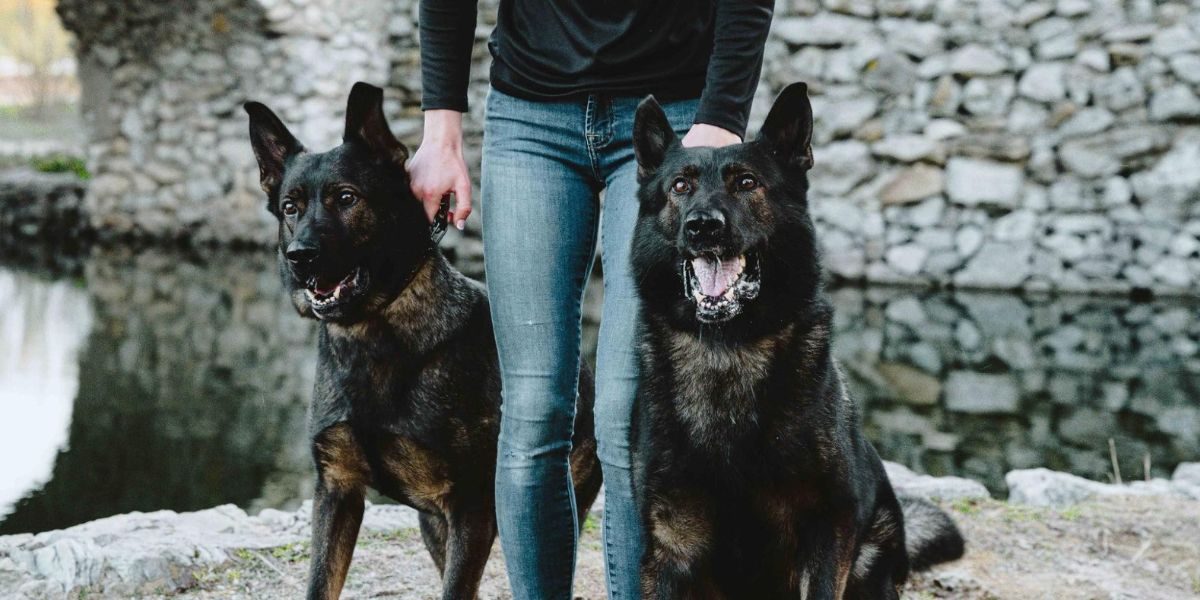By: Seraphina Caldwell
On a sprawling three-acre property just north of Dallas, a German Shepherd named Argo sits calmly beside his handler on a sun-dappled patio. No leash connects them. No treats are visible. The dog’s attentive eyes occasionally scan the horizon before returning to rest on his owner’s face. It’s an ordinary scene of companionship—until a signal, a single quietly spoken command, transforms the placid animal. In less than a second, Argo explodes with an aggressive bark, almost a scream, before launching across the yard toward a man emerging from behind a distant shed, intercepting the potential threat with a level of precision often associated with elite human operatives.
This is no ordinary protection dog demonstration. It’s the culmination of thousands of hours of highly specialized, scenario-based training at Canine Protection International (CPI), where dogs become part of an exceptionally trained unit—the $300,000 protection dog team designed to guard families, not perform for show.
Beyond Sport Training: The Science of Functional Protection
The distinction between sport-trained protection dogs and CPI’s Elite Family & Estate Protection Dogs lies in a fundamental philosophical difference that influences every aspect of the training process.
“Many people think a protection dog is just an aggressive dog, but the reality is more complex,” says Alex Bois, owner of CPI. “These dogs must be completely stable, confident in every scenario we put them in, and neutral to the world moving around them. When called upon, they can go from calm and relaxed to displaying controlled aggression.”
While most training centers in North America and Europe rely on what CPI describes as “dog sport training,” the company has developed an approach focused on functional results in real-world scenarios. Industry research suggests that 87% of so-called “protection dogs” fail basic scenario testing, often because they’ve been conditioned to respond only to specific cues—a sleeve-wearing decoy making codified threatening gestures that real-world assailants would never replicate.
Instead, CPI’s methodology emphasizes what behavioral scientists call “context-independent response training,” which may help dogs respond to threats under the command of a handler across varied environments without the need for equipment or artificial signals from a decoy. This requires a significant shift from traditional protection training.
The Three-Phase Training Protocol
CPI’s training methodology unfolds across three carefully structured phases, beginning with foundational training that instills core capabilities regardless of a dog’s previous experience. Unlike sport training, which aims for precision in controlled environments, CPI’s approach prioritizes adaptability.
The second phase focuses on teaching specific skills in both obedience and protection. A training expert notes that this phase is where the divergence from sport training becomes most evident: “Sport dogs learn to perform for short durations in predictable environments. CPI dogs are trained to perform in unpredictable environments. It’s a noticeable difference in neural conditioning.”
Perhaps most distinctive is CPI’s third phase: functionality. During this period, dogs transition from performing in controlled “classroom” environments to demonstrating their capabilities in diverse real-world settings. Exercises include scenarios that could challenge conventionally trained animals, such as responding to passive threats without obvious aggression cues, navigating complex environments, and maintaining protective vigilance despite distractions.
“If you can teach two people a common language, you can accomplish anything,” the CPI training philosophy states, highlighting their approach to creating a communication system between dog and handler that goes beyond traditional command structures. CPI owners do not become dog trainers. They do not carry around treats and a ball on the delivery of their new dog. Instead, they learn how to handle through effective communication, praise, and a bond that strengthens every day, reflecting the thousands of hours spent training every dog and the unique program that separates CPI from the rest.
The $300K Investment: Science Over Sentiment
Investing in a CPI protection dog isn’t simply a matter of cost. It’s about precision. Prices range from $100,000 to $300,000, depending on the dog’s level of training, natural ability, and client-specific requirements. CPI’s strict selection process evaluates hundreds of European-bred candidates each year, accepting fewer than 2% into the program. It’s not uncommon for CPI to reject dogs later sold to brokers and then to competitors, a fact Bois acknowledges with concern.
“A lot of dogs we decline end up for sale elsewhere as ‘protection dogs,’” he says. “Buyer beware. There are no regulations in this industry.”
Rather than choosing dogs for looks or lineage alone, CPI uses a battery of temperament tests, nerve strength assessments, and early socialization screenings. Their aim? High behavioral reliability in high-stress environments.
“Temperament is everything,” Bois says. “A dog that hesitates under pressure may become a liability. We only train dogs that show exceptional composure and judgment.”
The Integration Process: Creating a Family Guardian
CPI’s state-of-the-art 2,400-square-foot facility, located next to the owners’ home, serves as both a training center and home environment, allowing dogs to learn to transition seamlessly between protection and companionship roles. This dual-context training is designed to help with what behavioral scientists term “contextual discrimination”—the ability to determine appropriate responses based on environmental and handler cues.
When clients purchase a dog—investments ranging from $100,000 to $300,000—the relationship is just beginning. CPI’s proprietary three-day integration process includes:
- Instruction in public settings
- Complete off-leash handling techniques
- Car entry and exit protocols
- Home and public protection exercises
- Integration with family members and existing pets
“Our philosophy of ‘extreme ownership’ guides every facet of our operations,” CPI materials explain, highlighting their commitment to client satisfaction that extends far beyond the sale.
A Moral Framework for Canine Protection
Critics have raised ethical concerns around conditioning dogs for aggression. Bois is candid about the tension but insists CPI’s approach balances protection with animal welfare. These dogs are put through rigorous challenges and high levels of pressure. In the end, the dog always wins, tail wagging and ready for the next fight. “Just as humans training in self-defense must experience controlled resistance to learn effectively, these dogs undergo structured scenarios to build confidence. Traditional padded equipment alone doesn’t prepare them for real-world threats.”
“These dogs aren’t just brutes,” Bois explains. “They’re stable, loving family members with a job to do.”
It’s this balance, perhaps more than anything, that contributes to CPI’s loyal following. Clients often return for their second, third, or even fourth dog. Bois doesn’t push testimonials. He doesn’t have to.
The Final Return
As Argo circles back from his simulated threat interception, he slides quietly into a down position, resting his head between his paws. There’s no raised voice, no visible tension. Just a glance from his handler, and calm is restored.
For the families who own CPI dogs, that calm isn’t just emotional. It’s strategic. It’s worth every cent. And at up to $300,000 for a pair of dogs, it represents more than luxury—it’s a sophisticated, dynamic security solution.
In a crowded and often unregulated industry, Canine Protection International has carved a niche that’s as refined as it is rare. Their dogs don’t just bark on cue. They act with conviction. Their handlers aren’t taught to control their dogs with treats and toys. They’re taught to trust them with their lives.
And in the process, CPI hasn’t just trained a generation of elite protection dogs. They’ve helped redefine what it means to be safe.
Disclaimer: The content of this article is for informational purposes only. The training methods, costs, and effectiveness described may vary depending on the provider. Readers are encouraged to conduct independent research or consult with relevant experts before making any decisions regarding protection dogs or security services. This article does not endorse or guarantee the effectiveness of the products or services discussed. Always exercise caution and due diligence when considering any security-related investment or decision.

















